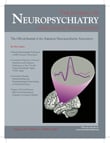REGULARFull Access
Published Online:1 Jan 2007
- Cited by
- 5 December 2023 | Perspectives of the ASHA Special Interest Groups, Vol. 10
- Journal of Nervous & Mental Disease, Vol. 211, No. 12
- The European Journal of Psychiatry, Vol. 35, No. 1
- NeuroImage: Clinical, Vol. 31
- 3 July 2017 | Irish Journal of Psychological Medicine, Vol. 37, No. 2
- 7 February 2020 | Psychiatry and Clinical Neurosciences, Vol. 74, No. 4
- 13 June 2019 | Clinical Linguistics & Phonetics, Vol. 34, No. 3
- 27 May 2015 | Language and Speech, Vol. 59, No. 2
- 19 April 2016 | Frontiers in Human Neuroscience, Vol. 10
- Neurology Clinical Practice, Vol. 5, No. 6
- 10 December 2012 | Communication Disorders Quarterly, Vol. 34, No. 4
- Perspectives on Neurophysiology and Neurogenic Speech and Language Disorders, Vol. 19, No. 3
Metrics
History
Published online 1 January 2007
Published in print 1 January 2007



